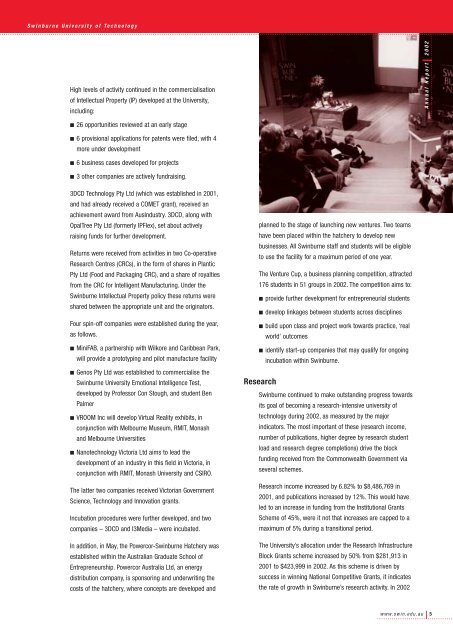Annual Report - Swinburne University of Technology
Annual Report - Swinburne University of Technology
Annual Report - Swinburne University of Technology
Create successful ePaper yourself
Turn your PDF publications into a flip-book with our unique Google optimized e-Paper software.
<strong>Swinburne</strong> <strong>University</strong> <strong>of</strong> <strong>Technology</strong><br />
High levels <strong>of</strong> activity continued in the commercialisation<br />
<strong>of</strong> Intellectual Property (IP) developed at the <strong>University</strong>,<br />
including:<br />
<strong>Annual</strong> <strong>Report</strong> 2002<br />
■ 26 opportunities reviewed at an early stage<br />
■ 6 provisional applications for patents were filed, with 4<br />
more under development<br />
■ 6 business cases developed for projects<br />
■ 3 other companies are actively fundraising.<br />
3DCD <strong>Technology</strong> Pty Ltd (which was established in 2001,<br />
and had already received a COMET grant), received an<br />
achievement award from AusIndustry. 3DCD, along with<br />
OpalTree Pty Ltd (formerly IPFlex), set about actively<br />
raising funds for further development.<br />
Returns were received from activities in two Co-operative<br />
Research Centres (CRCs), in the form <strong>of</strong> shares in Plantic<br />
Pty Ltd (Food and Packaging CRC), and a share <strong>of</strong> royalties<br />
from the CRC for Intelligent Manufacturing. Under the<br />
<strong>Swinburne</strong> Intellectual Property policy these returns were<br />
shared between the appropriate unit and the originators.<br />
Four spin-<strong>of</strong>f companies were established during the year,<br />
as follows.<br />
■ MiniFAB, a partnership with Wilkore and Caribbean Park,<br />
will provide a prototyping and pilot manufacture facility<br />
■ Genos Pty Ltd was established to commercialise the<br />
<strong>Swinburne</strong> <strong>University</strong> Emotional Intelligence Test,<br />
developed by Pr<strong>of</strong>essor Con Stough, and student Ben<br />
Palmer<br />
■ VROOM Inc will develop Virtual Reality exhibits, in<br />
conjunction with Melbourne Museum, RMIT, Monash<br />
and Melbourne Universities<br />
■ Nanotechnology Victoria Ltd aims to lead the<br />
development <strong>of</strong> an industry in this field in Victoria, in<br />
conjunction with RMIT, Monash <strong>University</strong> and CSIRO.<br />
The latter two companies received Victorian Government<br />
Science, <strong>Technology</strong> and Innovation grants.<br />
Incubation procedures were further developed, and two<br />
companies – 3DCD and I3Media – were incubated.<br />
In addition, in May, the Powercor-<strong>Swinburne</strong> Hatchery was<br />
established within the Australian Graduate School <strong>of</strong><br />
Entrepreneurship. Powercor Australia Ltd, an energy<br />
distribution company, is sponsoring and underwriting the<br />
costs <strong>of</strong> the hatchery, where concepts are developed and<br />
planned to the stage <strong>of</strong> launching new ventures. Two teams<br />
have been placed within the hatchery to develop new<br />
businesses. All <strong>Swinburne</strong> staff and students will be eligible<br />
to use the facility for a maximum period <strong>of</strong> one year.<br />
The Venture Cup, a business planning competition, attracted<br />
176 students in 51 groups in 2002. The competition aims to:<br />
■ provide further development for entrepreneurial students<br />
■ develop linkages between students across disciplines<br />
■ build upon class and project work towards practice, ‘real<br />
world’ outcomes<br />
■ identify start-up companies that may qualify for ongoing<br />
incubation within <strong>Swinburne</strong>.<br />
Research<br />
<strong>Swinburne</strong> continued to make outstanding progress towards<br />
its goal <strong>of</strong> becoming a research-intensive university <strong>of</strong><br />
technology during 2002, as measured by the major<br />
indicators. The most important <strong>of</strong> these (research income,<br />
number <strong>of</strong> publications, higher degree by research student<br />
load and research degree completions) drive the block<br />
funding received from the Commonwealth Government via<br />
several schemes.<br />
Research income increased by 6.82% to $8,486,769 in<br />
2001, and publications increased by 12%. This would have<br />
led to an increase in funding from the Institutional Grants<br />
Scheme <strong>of</strong> 45%, were it not that increases are capped to a<br />
maximum <strong>of</strong> 5% during a transitional period.<br />
The <strong>University</strong>’s allocation under the Research Infrastructure<br />
Block Grants scheme increased by 50% from $281,913 in<br />
2001 to $423,999 in 2002. As this scheme is driven by<br />
success in winning National Competitive Grants, it indicates<br />
the rate <strong>of</strong> growth in <strong>Swinburne</strong>’s research activity. In 2002<br />
www.swin.edu.au<br />
5

















